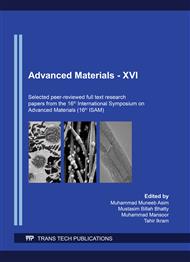[1]
R.E. Eitel, C.A. Randall, T.R. Shrout, P.W. Rehrig, W. Hackenberger and S-E. Park, New High Temperature Morphotropic Phase Boundary Piezoelectrics Based on Bi(Me)O3-PbTiO3 Ceramics, Jpn. J. Appl. Phys. 40 (2001) 5999-6002.
DOI: 10.1143/jjap.40.5999
Google Scholar
[2]
A. Sehirlioglu, A. Sayir and F. Dynys, High Temperature Properties of BiScO3-PbTiO3 Ceramics, J. Appl. Phy. 106 (2009) 014102.
DOI: 10.1063/1.3158542
Google Scholar
[3]
X. Shang, H. Liu, J. Guo, D. Jiang, T. Zhou and Y. He, Enhancing the Properties of High-Temperature BiScO3-PbTiO3 Piezoceramics via Bi Addition, Mater. Res. Bull. 48 (2013) 3072-3076.
DOI: 10.1016/j.materresbull.2013.04.060
Google Scholar
[4]
S. Zhang, R.E. Eitel, C.A. Randall, T.R. Shrout and E.F. Alberta, Manganese-modified BiScO3–PbTiO3 Piezoelectric Ceramic for high-temperature Shear Mode Sensor, Appl. Phys. Lett. 86 (2005) 262904.
DOI: 10.1063/1.1968419
Google Scholar
[5]
S.V. Halilov, M. Fornari and D.J. Singh, Lattice Instabilities and Ferroelectricity in AScO3 Perovskite Alloys, Phys. Rev. B 69 (2004) 174107.
Google Scholar
[6]
W-M. Zhu and Z-G. Ye, Improved Dielectric and Ferroelectric Properties of High Curie Temperature (1-x)BiFeO3-xPbTiO3 Ceramics by Aliovalent Ionic Substitution, Appl. Phys. Lett. 89 (2006) 232904.
DOI: 10.1063/1.2397560
Google Scholar
[7]
K. Shahzad, LiHua Li, Zhenrong Li and M. N. Khan, Structure and electrical properties of anion and cation doped BSPT ceramics, J. Alloys Compd. 1 (2018) 61-66.
Google Scholar
[8]
K. Shahzad, LiHua Li, Zhenrong Li, G. Shabbir, Hui Li and Xi Yao, Structural Characterization and Dielectric Properties of Sol-Gel Synthesized BiScO3-0.64PbTiO3 Ceramics, Ferroelectrics 402 (2010) 142-149.
DOI: 10.1080/00150191003708935
Google Scholar
[9]
J. Chaigneau, J.M. Kiat, C. Malibert, C. Bogicevic and Morphotropic Phase Boundaries in (BiScO3) 1−x(PbTiO3)x (0.60<x<0.75) and their Relation to Chemical Composition and Polar Order, Phys. Rev. B 76 (2007) 094111.
Google Scholar
[10]
E. Boucher, D. Guyomar, L. Lebrun, B. Guiffard and G. Grange, Effect of (Mn,F) and (Mg,F) co-doping on Dielectric and Piezoelectric Properties of Lead Zirconate Titanate Ceramics, J. Appl. Phy. 92 5437-5442 (2002).
DOI: 10.1063/1.1499526
Google Scholar
[11]
B. Guiffard, D. Audigier, L. Lebrun and M. Troccaz, Effects of fluorine–oxygen Substitution on the Dielectric and Electromechanical Properties of Lead ZirconateTtitanate Ceramics, J. Appl. Phy. 86 (1999) 5747-52.
DOI: 10.1063/1.371588
Google Scholar
[12]
G. Heartling, Ferroelectric Ceramic: History and Technology, J. Am. Ceram. Soc. 82 (1999) 797-818.
Google Scholar


